
Safety issues such as speeding, distracted and impaired driving are all contributing factors to the tens of thousands of people lost in preventable crashes on U.S. roads each year. To address the importance of policies that support a Safe System Approach to eliminate motor vehicle fatalities, NSC and its advocacy partners are heading to Capitol Hill to meet with federal legislators during infrastructure week to advocate for much-needed change.
“The most dangerous thing most people in our country do in a single day is use the U.S. roadway system. This public health crisis is an atrocity that must continue to be addressed,” said Mark Chung, executive vice president of roadway practice at NSC. “No one should die getting to or from their homes, schools and workplaces, but the current system was not designed with the safety of all road users in mind. This is why we must continue to speak, act and cooperatively work together across public and private sectors to prioritize the safe travel of all road users; this is our focus when visiting with lawmakers in the spring, to continue advocating for the safety of all road users and ultimately save lives.”
According to the analysis, 12 states experienced decreases in motor vehicle fatalities of 10% or more in 2023: Alaska, Maine, Delaware, Hawaii, Massachusetts, Connecticut, New Jersey, New Mexico, Utah, Georgia, New York and Louisiana. Conversely, seven states as well as the nation’s capital experienced increases of 10% or more compared to 2022 preliminary estimates: District of Columbia, Rhode Island, Arizona, Idaho, Iowa, North Dakota, Maryland and Kentucky.
Embracing the Safe System Approach at national, state and local levels is a critical step toward eliminating traffic fatalities nationwide. The Safe System Approach takes a holistic look at road safety by examining five elements of a safe transportation system: road users, speed management, vehicles, roads and post-crash care. Over two years ago, the U.S. Department of Transportation adopted the approach in its National Roadway Safety Strategy, and NSC joined as an Ally in Action, pledging to do its part to save lives on the roads. The road ahead may be long, but the shared commitment to saving lives is real and zero is possible.
Motor vehicle fatality estimates are subject to slight increases and decreases as data mature. The National Safety Council uses data from the National Center for Health Statistics, an arm of the CDC, so that deaths occurring within 100 days of the crash and on both public and private roadways – such as parking lots and driveways – are included in the Council’s estimates.
The National Safety Council has calculated traffic fatality estimates since 1913. Supplemental estimate information, including estimates for each state, can be found here.